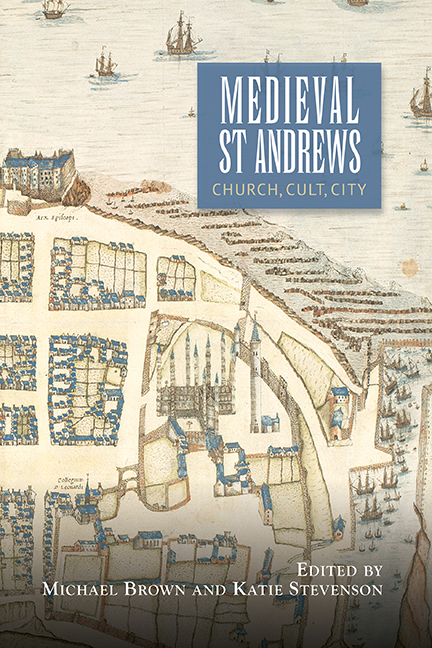Book contents
- Frontmatter
- Dedication
- Contents
- List of Illustrations, Charts and Tables
- Contributors
- Abbreviations
- 1 ‘Ancient Magnificence’: St Andrews in the Middle Ages: An Introduction
- 2 From Cinrigh Monai to Civitas Sancti Andree: A Star is Born
- 3 The Idea of St Andrews as the Second Rome Made Manifest
- 4 The Medieval Ecclesiastical Architecture of St Andrews as a Channel for the Introduction of New Ideas
- 5 When the Miracles Ceased: Shrine and Cult Management at St Andrews and Scottish Cathedrals in the Later Middle Ages
- 6 Religion, Ritual and the Rhythm of the Year in Later Medieval St Andrews
- 7 Living in the Late Medieval Town of St Andrews
- 8 The Burgh of St Andrews and its Inhabitants before the Wars of Independence
- 9 The Archaeology of Medieval St Andrews
- 10 Prelates, Citizens and Landed Folk: St Andrews as a Centre of Lordship in the Late Middle Ages
- 11 Augmenting Rentals: The Expansion of Church Property in St Andrews, c. 1400–1560
- 12 The Prehistory of the University of St Andrews
- 13 University, City and Society
- 14 The Medieval Maces of the University of St Andrews
- 15 Heresy, Inquisition and Late Medieval St Andrews
- Appendix 1 The St Andrews Foundation Account
- Appendix 2 The Augustinian' Account
- Appendix 3 The Boar' Raik
- Appendix 4 University of St Andrews Library, UYSL 110/6/4
- Index
- Miscellaneous Endmatter
10 - Prelates, Citizens and Landed Folk: St Andrews as a Centre of Lordship in the Late Middle Ages
Published online by Cambridge University Press: 28 April 2017
- Frontmatter
- Dedication
- Contents
- List of Illustrations, Charts and Tables
- Contributors
- Abbreviations
- 1 ‘Ancient Magnificence’: St Andrews in the Middle Ages: An Introduction
- 2 From Cinrigh Monai to Civitas Sancti Andree: A Star is Born
- 3 The Idea of St Andrews as the Second Rome Made Manifest
- 4 The Medieval Ecclesiastical Architecture of St Andrews as a Channel for the Introduction of New Ideas
- 5 When the Miracles Ceased: Shrine and Cult Management at St Andrews and Scottish Cathedrals in the Later Middle Ages
- 6 Religion, Ritual and the Rhythm of the Year in Later Medieval St Andrews
- 7 Living in the Late Medieval Town of St Andrews
- 8 The Burgh of St Andrews and its Inhabitants before the Wars of Independence
- 9 The Archaeology of Medieval St Andrews
- 10 Prelates, Citizens and Landed Folk: St Andrews as a Centre of Lordship in the Late Middle Ages
- 11 Augmenting Rentals: The Expansion of Church Property in St Andrews, c. 1400–1560
- 12 The Prehistory of the University of St Andrews
- 13 University, City and Society
- 14 The Medieval Maces of the University of St Andrews
- 15 Heresy, Inquisition and Late Medieval St Andrews
- Appendix 1 The St Andrews Foundation Account
- Appendix 2 The Augustinian' Account
- Appendix 3 The Boar' Raik
- Appendix 4 University of St Andrews Library, UYSL 110/6/4
- Index
- Miscellaneous Endmatter
Summary
ON 19 January 1435 the hall of the prior's house in St Andrews Cathedral Priory was the setting for a ceremony. James Kinninmonth had presented his claim as heir to his father, who had died a month earlier. He sought legal possession of the family's ancestral lands at Kinninmonth, which lay 7 miles west of St Andrews, from the superiors of this property, the prior and canons of St Andrews Cathedral. These rights had been confirmed in the prior's court by an inquisition of fifteen ‘noble and trustworthy men’ from the local area. ‘In the face of the whole court’ James ‘publically performed, made and solemnly swore a bodily oath of homage and fealty touching the Holy Gospels’ to the prior as head of the cathedral community. In response, Prior James Haldenstone invested his kneeling vassal in the lands by a red staff held by his sergeant. The bailie, in charge of administering the priory's estates, then presented James Kinninmonth with sealed letters which promised the recipient full possession of his lands. This formal occasion took place before a gathering of impressive size. Present were the canons of the cathedral, other clergy, leading citizens of St Andrews, the sheriff of Fife, and local landowners numbered at ‘around a hundred honest persons’ by the record of the gathering.
The record of this event, preserved in the letter book of Prior Haldenstone, provides a vivid account of the holding of his court. Describing the ceremony of homage and investiture, which were fundamental acts of landholding and social hierarchy across medieval Europe, it demonstrated that, amongst the numerous roles played by St Andrews in the Middle Ages, the city was also a centre of lordship. Alongside their spiritual and pastoral authority and duties, the great ecclesiastical charges and corporations of St Andrews were holders of wide earthly rights. In contrast to most of Scotland, in eastern Fife such baronial powers were overwhelmingly in the hands of ecclesiastical lords. The sixteenth-century Black Book of St Andrews recorded a ruling of the king's justiciars from 1309 which named three baronies within the Cursus Apri, the Boar's Raik.This was the territory around St Andrews which legend stated had been gifted to the church at its foundation. In it, baronial rights were held by the prior and canons, by the community of clerics in St Mary's Church (the former Culdee house) and by the bishop.
- Type
- Chapter
- Information
- Medieval St AndrewsChurch, Cult, City, pp. 205 - 222Publisher: Boydell & BrewerPrint publication year: 2017

